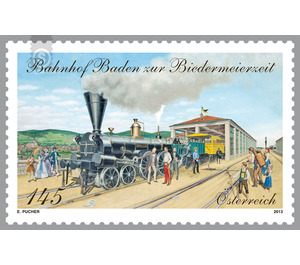stations - Austria / II. Republic of Austria 2013 - 145 Euro Cent
Theme: Architecture
| Country | Austria / II. Republic of Austria |
| Issue Date | 2013 |
| Face Value | 145.00 |
| Edition Issued | 400,000 |
| Printing Type | offset |
| Stamp Type | Commemorative |
| Item Type | Stamp |
| Chronological Issue Number | 2390 |
| Chronological Chapter | OOS-OE2 |
| SID | 670009 |
| In 62 Wishlists | |
This special stamp after a gouache created in 2011 by the archaeologist and railway enthusiast Erich Pucher shows a motif from the early days of the Südbahn against the background of his hometown Baden near Vienna. The centerpiece is the 1846 brand new locomotive "Bruck" of the Vienna-Gloggnitzer-Bahn. It is already a second-generation machine of the locomotives built in 1840 in the railway owned factory under John Haswell in Vienna. If the designer from Scotland initially leaned closely on British and American models, he soon went his own way, which shaped the Austrian locomotive construction for decades. The pursuit of detailed representation as possible forced extensive research and literature studies. Although no machine of the Bruck class was preserved, type sketches and photographs exist. In addition, the Technical Museum Vienna with the "Steinbrück" a very similar machine of the somewhat reinforced successor series from 1848, at the many individual parts can be studied. The cars of the Gloggnitzer Bahn were relatively spacious bogie wagons modeled after the US. The reception building of the Badener station was replaced after several conversions only 2004 by a new building, so that also the original condition and the at that time still branched tracks together with operating plants for the picture had to be reconstructed. Of course, the built-up area of the spa town in 1846 was much smaller than it is today, so that extensive green spaces had to be seen between the train and the city. In order to enliven the foreground, set the painter in front of the just arrived and after the track change not yet turned back to Vienna locomotive personalities whose meeting in Baden, although not historically documented but by no means unlikely. Haswell explains the machine to Archduke Albrecht, who lives in the Baden Weilburg, after a demonstration run specially for the general, and the planner and operations manager of the Gloggnitzer Bahn, Matthias Schönerer, keeps the documents ready for the railway operations. Archduke Albrecht was one of the first to recognize the benefits of the new railroad for the military, and Schönerer was responsible for the transport of troops in 1848. The remaining persons are an adjutant, railwaymen and fencekeepers, on the left a bourgeois family in current Biedermeier fashion, on the right a winegrowing family in her then also on the thermal line still alpine-looking costumes. Entering the tracks was not yet prohibited. The Biedermeier period is often described today only as one-sided as Vormärz and time of reaction. It ignores the fact that it was a very fruitful time for art, science and technology to break through and that it brought profound changes in all circumstances. The here described confrontation of the new technology with the old high nobility, the knowledge-thirsty citizens and the tradition-bound farmers may clarify the true multi-faceted wealth of this time. The absence of thresholds is not an error! These were covered with sand, so that the horses, if they have to tow a stuck train, can walk between the rails!


